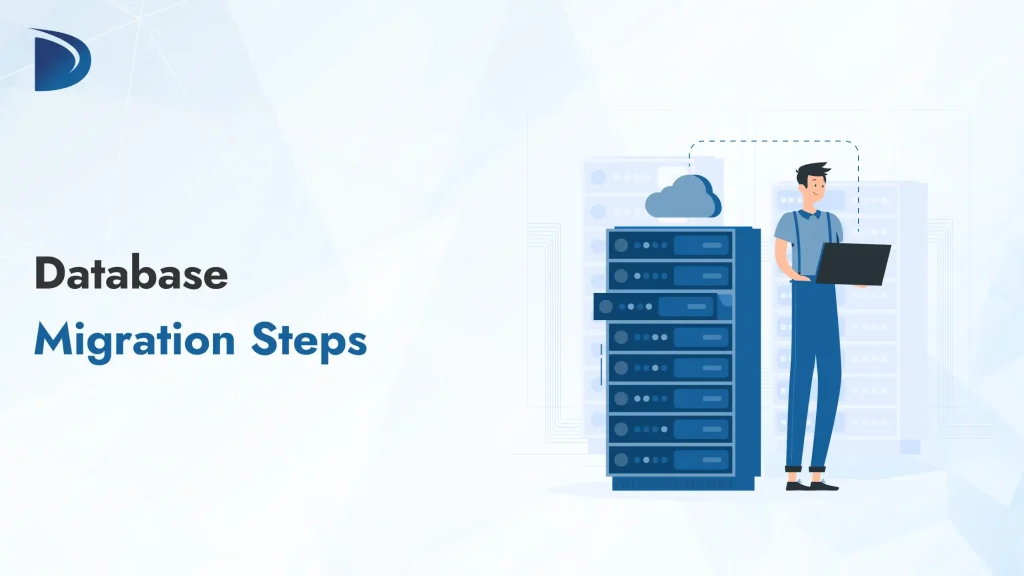Table of Contents
Moving data from one system to another can seem challenging, but it doesn’t have to be. Knowing the right database migration steps helps make the process easier and more organized.
Whether you’re upgrading systems, switching to a new platform, or moving data for better performance, following these steps will keep everything on track. In this blog, we’ll walk you through each stage of database migration, giving you clear tips to avoid common mistakes and get the best results from your new system.
What Is Database Migration?
Database migration is simply the process of moving data from one database to another or from one system to another. This might be done for several reasons like upgrading systems, moving to a cloud service, or improving performance. The goal is to make sure data stays secure, works well, and is accessible after the move.
Database Migration Steps for a Smooth Transition
Migrating a database doesn’t have to be intense. By following these simple steps, you can make the process more organized and less stressful. Whether you are moving data to the cloud, upgrading your systems, or switching databases, these steps will guide you through.
Step 1. Plan and Assess
Start by reviewing your current database and identifying what needs to be moved. Understand the reason for the migration, like improving performance or switching systems. This helps you know what to expect and how to handle the move.
Step 2. Backup Your Data
Before you begin, always back up your data. This ensures that if something goes wrong, you won’t lose important information.
Step 3. Choose the Right Method
Decide if you’ll use tools to help with the migration or do it manually. Tools can make the process quicker, especially for bigger databases, but manual steps might be simpler for smaller ones.
Step 4. Migrate the Data
Move your data from the old system to the new one. Be careful to make sure all tables, indexes, and other parts of the database are transferred correctly.
Step 5. Test and Check
After the migration, check that everything works properly. Look for any missing data or errors and make sure the system runs smoothly.
Step 6. Monitor and Support
Once everything is moved, keep an eye on the new system. Offer support if needed and fix any problems that come up. Make any needed adjustments to make sure everything keeps running well.
Best Practices for Executing Database Migration Steps
Using the right practices can help make your database migration easier and safer. Here are some simple tips to follow:
i) Plan Ahead and Set Clear Goals
Know why you’re moving the data and what you want to achieve, like better speed or saving costs. Planning helps you stay focused and avoid surprises.
ii) Always Backup Your Data
Before you start moving anything, back up all your data. This way, if something goes wrong, you can restore everything.
iii) Test Migration with Small Data First
Try moving a small part of your data first to see if everything works well. This helps catch problems before moving all the data.
iv) Use the Right Tools
Use tools that are made for database migration. They can speed up the process and help you avoid mistakes.
v) Keep an Eye on Progress
Watch how the migration is going. Check for any issues and fix them right away to keep everything on track.
vi) Test and Optimize After Migration
After moving the data, check everything to make sure it’s correct and working well. If something isn’t right, make the necessary changes.
vii) Have a Plan to Go Back If Needed
In case something goes wrong, have a plan to restore the backup and get things back to normal quickly.
viii) Write Down the Process
Keep a record of all the steps, tools, and any issues that come up. This will help you if you need to do it again in the future.
Types of Database Migration Steps
| Migration Type | Description | Best for | Tools Commonly Used |
| Homogeneous Migration | Moving data between the same database systems, e.g., from one version of MySQL to another. | Ideal for businesses already using the same database system, especially for system upgrades. | MySQL Workbench, Oracle Data Pump, SQL Server Management Studio |
| Heterogeneous Migration | Migrating data between different types of databases, e.g., from Oracle to MySQL. | Suitable for businesses switching to a more cost-effective or scalable database solution. | AWS Database Migration Service, Oracle GoldenGate, Attunity |
| Cloud Migration | Moving data from on-premise databases to cloud platforms like AWS, Azure, or Google Cloud. | Ideal for businesses looking to scale operations or reduce infrastructure costs. | AWS DMS, Google Cloud Data Transfer, Azure Database Migration Service |
| Database Consolidation | Combining data from multiple databases into one. | Best for businesses managing several databases and looking to simplify operations. | Redgate SQL Toolbelt, DBArtisan, Microsoft SQL Server |
| Disaster Recovery Migration | Moving data to backup systems to prevent data loss in case of system failure or disaster. | Crucial for industries where data recovery is essential, like finance, healthcare, and retail. | Veeam Backup & Replication, Zerto, Acronis |
| Upgrade Migration | Moving data to a newer version of the same database system to improve performance and security. | Best for organizations keeping their existing database but needing new features or updates. | DB2 Upgrade Tool, MySQL Upgrader, Oracle Upgrade Assistant |
Conclusion
Following the right database migration steps is crucial for a smooth and successful transition. By planning ahead, testing throughout, and using the appropriate tools, you can minimize disruptions and ensure data integrity. Proper preparation, including backing up your data, reduces errors and downtime. Keeping track of each step ensures the process is organized and helps achieve the best results for your business.
FAQs
What are some practical tips on reducing downtime and ensuring data integrity.
Plan and Test Ahead: Start with testing a small portion of data before the full migration. This helps identify any issues without affecting the entire system.
Backup Data: Always back up your data before starting migration. This provides a safety net in case anything goes wrong.
Schedule During Off-Peak Hours: If possible, plan the migration during off-peak hours to minimize disruptions for users.
Monitor Progress: Keep track of the migration process to quickly spot and resolve any issues that could lead to downtime.
What are some examples of common mistakes and how to avoid them?
Skipping the Backup Process: Never start migration without confirming you have a full data backup. This can lead to severe data loss in case of failure.
Not Testing First: Trying to migrate everything at once without testing with a smaller batch can result in unforeseen errors. Always test first.
Choosing the Wrong Tools: Selecting tools that don’t align with your database types or needs can complicate the process. Research and choose tools that fit your specific migration type.
Ignoring Post-Migration Testing: After migration, verify the data thoroughly to ensure it has been transferred correctly. Missing this step can lead to data inconsistencies.
How do I choose the right database migration tool?
Choose a tool based on your migration type (homogeneous, heterogeneous, cloud migration, etc.), the size of your data, and the specific database systems involved. Research each tool’s features and compatibility with your current systems.
How can I reduce disruption to business operations during migration?
Timing the Migration: Schedule migrations during non-business hours when possible.
Real-Time Replication: Use tools that support real-time replication to ensure the business continues to run without interruption.
Communication: Keep stakeholders informed about the migration schedule and potential impact to avoid surprises.
How do I handle migration for large databases?
For large databases, it’s important to break down the migration into smaller, manageable parts. Use automated tools to streamline the process, and ensure data integrity through thorough testing at each step.
What should I do if the migration fails?
If migration fails, restore the data from your backup and identify the root cause of the issue. Depending on the failure, you may need to retry the migration using different tools or methods. Always have a rollback plan in place.

